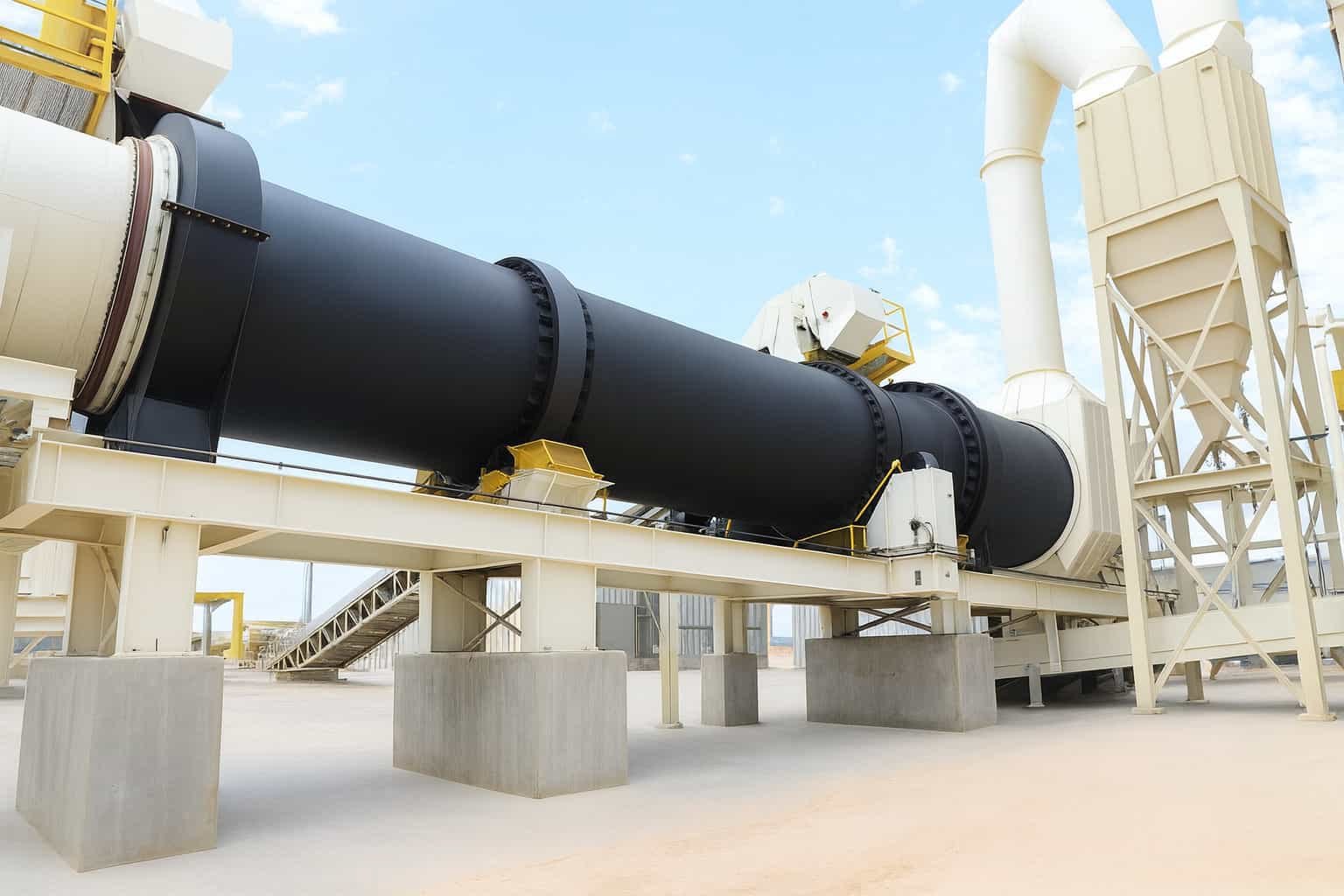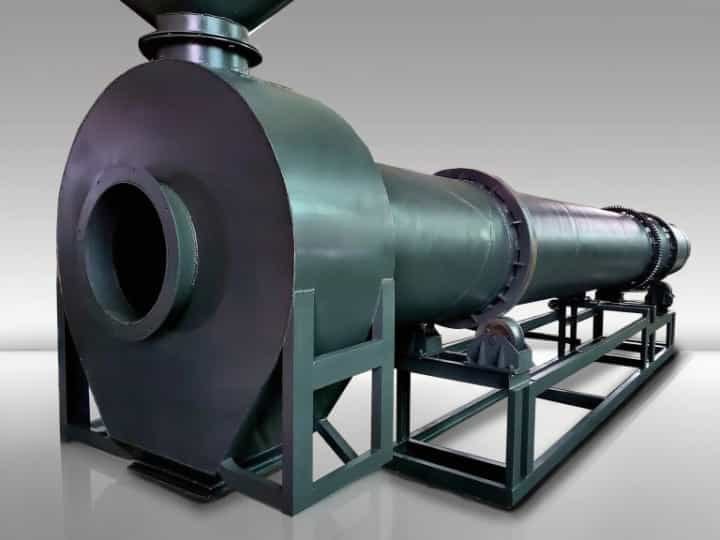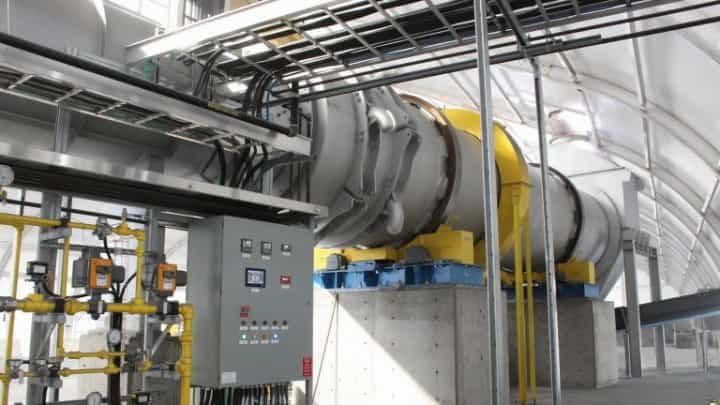A rotary dryer is a big drum that spins around. It takes water out of large amounts of materials. The main job of a rotary dryer is to dry things like minerals, grains, or wood chips. Many businesses use this machine to dry things quickly. When people ask, “what is rotary dryer,” they want to know how it dries lots of different things. Learning what is rotary dryer helps companies pick the best way to dry their stuff.
Key Takeaways
Rotary dryers have a big spinning drum and use hot air. They take water out of lots of things like minerals, grains, and wood chips.
The drum lifts and drops the material inside. This helps the hot air dry everything fast and evenly. There are two main heating types. Direct means hot air touches the material. Indirect means heat goes through the drum.
Rotary dryers can dry many kinds of materials. They can dry large amounts very quickly. This makes them common in mining, food, and chemical factories.
They give steady and flexible drying. But they need more space and energy than some other dryers. Some materials might break inside the drum.
Picking the right rotary dryer depends on what you want to dry. You also need to think about how wet it is, how much you have, and your space. Regular care keeps the dryer working well.
What Is Rotary Dryer
A rotary dryer is an industrial machine used to reduce moisture content in bulk materials by rotating them in a cylindrical drum. This process is commonly used in mining, agriculture, and chemical industries.

Definition
A rotary dryer is a machine that dries big amounts of material. It has a large drum that turns slowly at a slight angle. Material goes in one end and moves through the drum as it spins. Gravity and the turning drum help move the material along. This setup makes rotary dryers different from other dryers. The table below shows how rotary dryers and fluid bed dryers are not the same:
Aspect | Rotary Dryer | Fluid Bed Dryer |
|---|---|---|
Definition | Slightly tilted, spinning drum where gravity and motion move material. | Air blows through a plate to lift and dry particles in hot air. |
Material Movement | Material is lifted and dropped inside the drum by flights, making a curtain in the hot air. | Air lifts each particle, so hot air touches all sides for even drying. |
Particle Size & Feed | Can handle bigger pieces and heavier loads; works with different feed types. | Needs even particle size and moisture; special airflow needed. |
Thermal Efficiency | Uses more energy; works at higher heat; heat is less even. | Saves more energy because heat spreads well; dries fast and evenly. |
Capacity & Space | Good for drying lots of material; takes up more room. | Smaller and fits in places with less space and less material. |
Operational Flexibility | Can handle tough jobs and changes in feed; can save energy when not full. | Not as flexible; works best with steady feed and airflow. |
When people ask, “what is rotary dryer,” they want to know how it works and why it is special.
Main Function
Rotary dryers are important in many industries. Their main job is to take water out of solid materials. They do this by lifting and dropping the material in hot air inside the drum. This makes the water turn into vapor and leave the material. Rotary dryers get materials ready for the next step, keep products safe, and make shipping cheaper. Mining, farming, and chemical companies use rotary dryers to dry things like minerals, grains, and wood chips. When companies ask what is rotary dryer, they want to know if it can dry a lot of material fast.
Rotary dryers can remove a lot of water. For example:
Some ores start with about 49% water.
After drying, water drops to 3% to 5% if conditions are good.
Drying goes faster with hotter air, sometimes up to 900 °C.
Most rotary dryers can dry 40 to 50 tons every hour.
These facts show why rotary dryers are a top choice for drying big amounts of material.
Key Features
Rotary dryers have many features that make them useful:
Large Capacity: They can dry from 10 pounds to over 100 tons each hour.
Size Range: Drums can be 1 to 14 feet wide and up to 150 feet long.
Material of Construction: They are made from carbon steel, stainless steel, or special metals for different jobs.
Adaptability: They work with many sizes and types of material.
Consistent Drying: Flights inside lift and drop the material, so hot air touches it evenly.
Operational Flexibility: They work well even if the amount of material changes.
Note: Rotary dryers are a good pick for companies that need to dry a lot of material quickly and well.
When someone asks, “what is rotary dryer,” they find out it is a strong tool for drying many kinds of bulk materials. Rotary dryers are one of the most common drying machines in factories.
How Rotary Dryers Work
Rotary dryers work by using a rotating drum to tumble and dry materials through direct or indirect heat. The drum is inclined slightly to allow gravity to assist in moving material through the dryer.
Structure and Components
A rotary dryer has many important parts that help it dry things well. The main part is the drum, which spins and tilts a little. This tilt helps move material from one end to the other. As the drum spins, gravity helps pull the material forward. Inside the drum, there are plates called flights. These flights lift and drop the material as the drum turns. This helps the material touch the hot air more often, so it dries better.
The table below lists the main parts of rotary dryers and what they do:
Component | Function |
|---|---|
Furnace | Gives heat for drying. |
Feeding Conveyor | Moves material into the drum. |
Inlet | Where material enters the drum. |
Feeding Cover | Keeps heat and material inside the feeding area. |
Roller Ring | Holds up the drum and lets it spin. |
Carrier Roller | Helps guide and support the drum. |
Drum | The spinning cylinder where drying happens. |
Transmission | Makes the drum spin. |
Gear Ring | Connects to the transmission to turn the drum. |
Discharge Cover | Covers the exit area to control material leaving. |
Dust Collector | Catches small particles made during drying. |
Chimney | Lets out gases and dust. |
Induced Draft Fan | Moves air to take away moisture and gases. |
Motor | Powers the drum and transmission. |
Outlet | Where dried material comes out. |
Discharging Conveyor | Takes dried material away from the dryer. |
Tip: The spinning drum and flights inside help make sure everything dries the same.
Drying Process
Rotary dryers use a simple way to dry things. Material goes into the drum through the inlet. The drum spins and the flights inside lift and drop the material. Hot air moves through the drum, sometimes in the same way as the material, or the opposite way. As the material tumbles, it meets the hot air again and again. This makes the water in the material turn into vapor.
Material moves through the drum because of the tilt and spinning. The time the material stays inside is called residence time. For things like alfalfa feedstock, this time is about 1.7 to 1.8 minutes in small lab dryers. The real time depends on how big, heavy, or shaped the material is, and how fast the drum spins and air moves.
The dust collector and chimney help handle small bits and gases. The induced draft fan keeps air moving, which helps take away moisture and control how things dry.
Note: How a rotary dryer works can change based on what you are drying and how wet it is.
Direct vs Indirect Heating
Rotary dryers can use two ways to heat things: direct or indirect. In direct rotary dryers, hot air from the furnace goes right through the drum. The material mixes with the hot air, so it dries faster. This way works best for things that can touch hot gases without getting hurt.
Indirect rotary dryers work differently. The drum gets hot from the outside, and the material does not touch the hot gases. Heat moves through the drum wall instead. This way is better for things that need gentle drying or could get damaged by hot air.
Most rotary dryers work at 200 to 300 °C. Workers change the heat and air speed to fit what they are drying. The right heat helps dry things fast without hurting them.
Remember: You pick direct or indirect heating based on what you are drying and how you want it to turn out.
What Are the Different Types of Rotary Dryers?
Rotary dryers have different types. Each type is good for certain jobs. The main way to group them is by how they heat things.

Direct Rotary Dryers
Direct rotary dryers use hot gases inside the drum. The material mixes with these gases. This dries things fast. Many factories use direct rotary dryers for big or rough materials. Mining, cement, and chemical plants like this type. Hot air touches the material and takes away water quickly. These dryers can dry a lot at once and work with strong materials.
Indirect Rotary Dryers
Indirect rotary dryers heat the drum from the outside. The material never touches the hot gases. Heat moves through the drum wall instead. This gentle way is good for things that can get hurt by heat. Companies use indirect rotary dryers to keep the air clean or protect the product. These dryers are used in food, medicine, and fine chemical factories.
Tip: Indirect rotary dryers keep materials safe from strong gases and high heat.
Other Variations
Rotary dryers can have special parts to help them work better. One important part is the flights inside the drum. Flights are metal plates that lift and drop the material. Different shapes of flights change how the material moves and dries. Some common flight shapes are:
Straight flights
Single bend flights
Double bend flights
Radial flights
Engineers pick the flight shape based on how wet the material is, its shape, and how fast the drum turns. Some dryers use special flights at the start of the drum. These flights make a spiral and move the material gently. A bald spot, or area with no flights, can keep soft materials safe. Flights can be made from carbon steel, AR steel, or stainless steel.
The right flight shape makes a curtain of material. This curtain lets hot air touch more of the material. It helps dry things evenly and quickly. Rotary drum dryers use these ideas to dry many kinds of materials.
What Are the Advantages and Disadvantages of Rotary
Rotary engines, also known as Wankel engines, offer high power-to-weight ratios and smooth operation due to fewer moving parts. However, they suffer from lower fuel efficiency and higher emissions compared to traditional piston engines.

Benefits
Rotary dryers have many good points for drying things in factories. They can dry a lot of wet material at once. Both direct and indirect rotary dryers work well and dry things fast. Direct rotary dryers use hot gases that touch the material. This helps dry wet things quickly. Indirect rotary dryers heat the drum from the outside. The material never touches the hot gases. This is good for things that are easy to burn or spoil.
Some main benefits are:
They dry many kinds of materials well.
They work with very wet materials.
Direct rotary dryers dry things fast and help make more products.
Indirect rotary dryers dry things evenly and keep them safe.
Indirect rotary dryers lower the chance of mixing in bad stuff, so the product stays good.
Indirect rotary dryers make less bad gas and are better for the earth.
They can use clean energy and special systems to control pollution.
They help make better products and save energy for companies.
Rotary dryers are trusted by many factories because they work well and are used a lot.
Drawbacks
Rotary dryers have some problems too. The table below shows the main problems people see when using them:
Disadvantage / Limitation | Rotary Dryer Characteristics |
|---|---|
Spatial Footprint | Needs more space in factories than fluid bed dryers. |
Material Attrition & Degradation | Some material can break or wear out from rolling inside the drum. |
Thermal Efficiency | Does not use heat as well as fluid bed dryers. |
Energy Consumption | Uses less energy but does not reach the best heat use. |
Material Sensitivity | Not the best for things that must stay whole; fluid bed dryers are better for very soft items. |
Note: Companies should think about these things before picking a dryer for their work.
What Are the Applications of Rotary Dryers?
Rotary dryers are used to remove moisture from bulk solids, making them ideal for drying a wide variety of materials in industries such as agriculture, mining, and pharmaceuticals. They offer efficient drying solutions for large-scale operations.

Common Industries
Rotary dryers are used in many different fields. Heavy industry uses rotary dryers a lot. They need to dry big amounts of material fast. Manufacturing uses rotary dryers too, especially for food processing. Food companies dry ingredients to keep food safe and good. Chemical and petrochemical companies use rotary dryers for their products. The energy and biofuel field is growing fast. More companies use rotary dryers to dry renewable materials. Other important users are mineral processing, cement making, and industrial factories.
Main industries using rotary dryers:
Heavy industry
Food processing
Chemical and petrochemical
Energy and biofuel
Mineral processing
Cement production
Industrial manufacturing
Rotary dryers help these industries save time and make better products.
Typical Materials
Rotary dryers can dry many kinds of materials. They work well with things that flow easily, like grains, seeds, and pellets. Companies use rotary dryers for sand, ore, and minerals. Wood chips, sawdust, and biomass also dry well in rotary dryers. In food factories, rotary dryers dry cereals, flour, and other foods. Chemical plants use rotary dryers for powders and crystals. The table below lists common things dried in rotary dryers.
Material Type | Example Products |
|---|---|
Minerals | Sand, ore, limestone |
Biomass | Wood chips, sawdust |
Food ingredients | Grains, cereals, flour |
Chemicals | Powders, crystals |
Industrial waste | Sludge, filter cake |
Key Considerations
Companies think about many things when picking a dryer. They look at what material they need to dry. They check how wet it is and how much they have. Rotary dryers are best for bulk solids and things that flow easily. The drying temperature and how gentle the drying needs to be are important. Some things need soft drying to keep their shape or quality. Companies also think about energy use, space, and how the dryer fits in their system.
Tip: Choosing the right rotary dryer helps companies use less energy and get better results.
Rotary dryers have a spinning drum and use hot air to dry things. They take water out of large amounts of material. The main parts are the drum, flights that lift the material, and systems that collect dust. There are direct rotary dryers and indirect rotary dryers. Each type works best with certain materials. Rotary dryers can dry a lot at once and work with many materials. They are also known for being steady and strong. But they can use a lot of energy and need a lot of space. Many businesses like mining, farming, and food factories use rotary dryers to dry things quickly.
Learning about rotary dryer technology helps workers make better products. It also helps save energy and protect the environment. To learn more, check out guides on how to pick and take care of dryers.
FAQ
What materials can a rotary dryer handle?
A rotary dryer can dry many things. It works with sand, ore, grains, wood chips, and chemicals. Factories use rotary dryers for small or big batches.
How does a rotary dryer remove moisture?
The drum spins and lifts the material up. Hot air moves through the drum. The heat changes water into vapor. The vapor goes out through the exhaust.
What is the difference between direct and indirect rotary dryers?
Direct rotary dryers let hot air touch the material inside. Indirect rotary dryers heat the drum from the outside. The material never touches the hot gases.
How do you choose the right rotary dryer size?
Engineers check what kind of material needs drying. They look at how wet it is and how much there is. They also think about space and energy use. A table helps compare choices.
Factor | What to Check |
|---|---|
Material Type | Size, shape, flow |
Moisture Level | Starting and target |
Capacity | Tons per hour |
Space | Room for equipment |
How do you keep a rotary dryer working well?
Regular checks help keep a rotary dryer running right. Workers should clean the drum and look at the flights. They need to check for damage. Good care stops problems and keeps drying steady.


